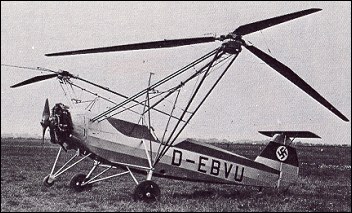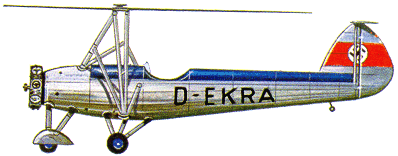
| Focke-Wulf Fw 61 1937 |  |
 |

| Focke-Wulf Fw 61 1937 |  |
 |
|
As a class of vehicle the helicopter had no single inventor, any more than the fixed-wing aeroplane did. Much of the credit for the modern helicopter goes, deservedly, to Igor Sikorsky; but in Britain, France, Italy, Germany and the U.S.S.R. contemporaries of Sikorsky all produced significant designs well before the historic VS-300 had left the ground. High on the short list of helicopter pioneers must come the name of Doktor Heinrich Karl Johann Focke, whose Fw 61 made its first free flight, lasting 28 seconds, on 26 June 1936. This was, coincidentally, exactly one year after the less-publicised flight of the Breguet-Dorand machine, which can thus claim to have been the first really practical helicopter to have flown in Europe. But the Fw 61, once it had begun to fly, rapidly proved itself a much superior machine to the Breguet, not only as regards performance but as a practical basic design capable of much further development. The Focke-Achgelis GmbH was an offshoot of the Focke-Wulf Flugzeugbau, established after Focke had been dismissed from the latter company by the Nazis as a political embarrassment. Focke's first experience of rotorcraft construction and operation was gained from building the Cierva C.19 and C.30 autogiros under licence, and then in 1934 he built and flew successfully a scale model helicopter that rose to a height of some 18m. There followed a period of research into, and testing of, rotor and transmission systems before, in 1936, the Fw 61 prototype made its appearance. Registered D-EBVU, the Fw 61V1 utilised the fuselage and Sh.14A engine of a Focke-Wulf Fw 44 Stieglitz basic trainer, with the tailplane mounted on top of the fin and the propeller cut down to the diameter of the engine cylinders to serve purely as a cooling fan. It gave no assistance to the aircraft in forward flight, though its presence may have led the Hungarian engineer von Asboth to believe that the Fw 61 was really an autogyro, for he vehemently challenged the helicopter records set up by the German machine. Focke confirmed, however, that not only were these all genuine helicopter flights, but that every landing was made vertically. The twin rotors, mounted on steel-tube outriggers on either side of the cabin, were fully-articulated 3-blade assemblies whose blade angle could be increased or decreased so as to provide lateral movement of the aeroplane by creating a lift differential between one side and the other. In May 1937, some months before a similar feat was accomplished by the Breguet-Dorand helicopter, the Fw 61 made its first landing using autorotation, and in February 1938 the aircraft's controllability was convincingly demonstrated by Germany's celebrated aviatrix Hanna Reitsch, who flew the machine inside the Deutsch-landhalle sports stadium in Berlin. Meanwhile a second prototype, D-EKRA, had been completed, and from mid-1937 the Fw 61 established the following list of FAI world records for helicopters: 25/26 June 1937 (pilot Ewald Rohlfs): 2439m altitude; 1 hr. 20 min. 49 sec. endurance; 80.604km distance in a straight line; 122.553km distance over a closed circuit; 16.40km/h speed over a closed circuit. 25 October 1937 (pilot Hanna Reitsch): 108.974km distance in a straight line. 20 June 1938 (pilot Karl Bode): 230.348km distance in a straight line. 29January 1939 (pilot Karl Bode): 3.427m altitude. The obvious promise in the Fw 61's basic design led to a development contract for a 6-passenger feeder transport, the Fa 266 for Deutsche Lufthansa, and a prototype of this aircraft (D-OCEB) was completed during the early part of 1939. War intervened, however, before this machine could be flown, and it was subsequently developed for a military role with the type number Fa 223. K.Munson "Helicopters And Other Rotorcraft Since 1907", 1968
Using as a starting point the experience gained from 1932 by Prof Heinrich Karl Focke in the licence building of Cierva Autogiros, the Focke Achgelis company began a series of helicopter experiments and model tests which culminated in the design of the Fa 61. Although a helicopter, the Fa 61 showed signs of having been influenced by the Cierva C.19 Autogiro, but its most strikingly obvious difference was its twin rotors mounted side by side. This layout of the rotors was to prove so successful in the helicopter field that Focke pursued it throughout the war (during which time nations such as Britain, the USA, and the USSR also produced helicopters with similar rotor mountings), and his rotor designs were further characterized by their exceptionally high disc loadings for the time. The fuselage of the Fa 61 was no more than that of a conventional light aircraft with horizontal stabilizer attached to the top of the fin and rudder, a single open cockpit, a nose-mounted 160hp Bramo Sh 14A radial engine with a small two-blade cooling propeller, and a tail-sitting undercarriage. To prevent nosing-over, there was a small wheel fitted beneath the nose. Extending from either side of the forward part of the fuselage were two tubular-steel outrigger structures, which terminated in the rotor heads. A system of gears and shafts transmitted the engine power out to the two rotors, which revolved in opposite directions, each rotor having three articulated and tapered blades with cyclic pitch for longitudinal and directional control. Differential operation of the cyclic pitch gave lateral control by inducing asymmetric rotor lift. With the test pilot Ewald Rohlfs at the controls, the Fa 61 made its first flight, of 28 seconds, on 26 June, 1936, and made its first autorotative landing in May the following year. Once developed, the great success of the machine was demonstrated by the series of new FAI world rotorcraft records it established until the start of the war, when official recording became impossible. On 25 June, 1937, with Rohlfs at the controls, the Fa 61 established an altitude record of 2,439m and an endurance record of 1 hr 20 min 49 sec. The following day, the same pilot and machine established a straight-line distance record of 16.4km, a closed-circuit distance record of 80.604km and a straight-line speed record of 122.553km/h over a 20km course. On 25 October, 1937, the straight line distance record was broken by Hanna Reitsch, who flew the Fa 61 helicopter 108.974km between Bremen and Berlin, and she also flew the machine indoors in the Deutschlandhalle, Berlin, in February 1938 to demonstrate the Fa 61's ease of control and sensitivity. The straight-line distance record was broken yet again by the Fa 61 on 20 June, 1938, when Karl Bode flew it 230.348km, and he established a new altitude record of 3,427m with the machine on 29 January, 1939, this being the last official record obtained by a German rotorcraft of pre-1945 vintage. Despite the great success of the Fa 61 and the large amount of publicity its noteworthy flights received, it was in reality no more than an experimental machine to put Prof Focke's ideas to the test. There was, however, to have been a two-seat sports version of the Fa 61, designated Fa 224, which would have had performance augmented by use of the more powerful 270hp Argus As 10C engine, but this was shelved with the advent of war. By 1938, design was already under way of a far more ambitious and useful helicopter, the Fa 266 (otherwise Fa 223). J.R.Smith, Antony L. Kay "German Aircraft of the Second World War", 1972  Heinrich Focke's rotary-wing experience was gained initially from licence production of Cierva C.19 and C.30 autogyros, leading to development of the Focke-Wulf Fw 61 helicopter. The fuselage was similar to that of a light fixed-wing aircraft with a 119kW Bramo Sh. 14A radial engine mounted in the nose, the primary purpose of this power-plant being to drive two outrigger-mounted three-bladed counter-rotating rotors; it also turned a small-diameter conventional propeller for engine cooling purposes. The rotors were fully articulated and control was achieved by the use of cyclic pitch, differential pitch and differential collective pitch in the longitudinal, directional and lateral axes respectively. Vertical control was achieved by varying rotor revolutions through the use of the throttle, in contrast to the present method of maintaining reasonably constant rotor speed and altering the pitch of the blades. Following a maiden flight on 26 June 1936, one that is usually reported as lasting for 28 seconds, but which is recorded in Heinrich Focke's log book as 45 seconds, the Fw 61 prototype completed its initial development programme and then established a number of world rotorcraft records. On 25 June 1937 Ewald Rohlfs flew it to a height of 2440m and remained airborne for 1 hour 20 minutes 49 seconds. Next day he set a straight-line distance record of 16.40km, a closed-circuit speed record of 122.55km/h and a closed-circuit distance record of 80.6km. Perhaps the most publicised flight was that made by Hanna Reitsch in the Deutschlandhalle during February 1938. Such achievements encouraged Deutsche Lufthansa to order a passenger-carrying development of this helicopter, leading to the Fa 223 and Fa 266. By then Heinrich Focke had formed the new company Focke-Achgelis & Co. GmbH to concentrate on his interest in rotary-wing aircraft, this explaining the redesignation of the Fw 61 as the Fa 61. D.Donald "The Complete Encyclopedia of World Aircraft", 1997
|